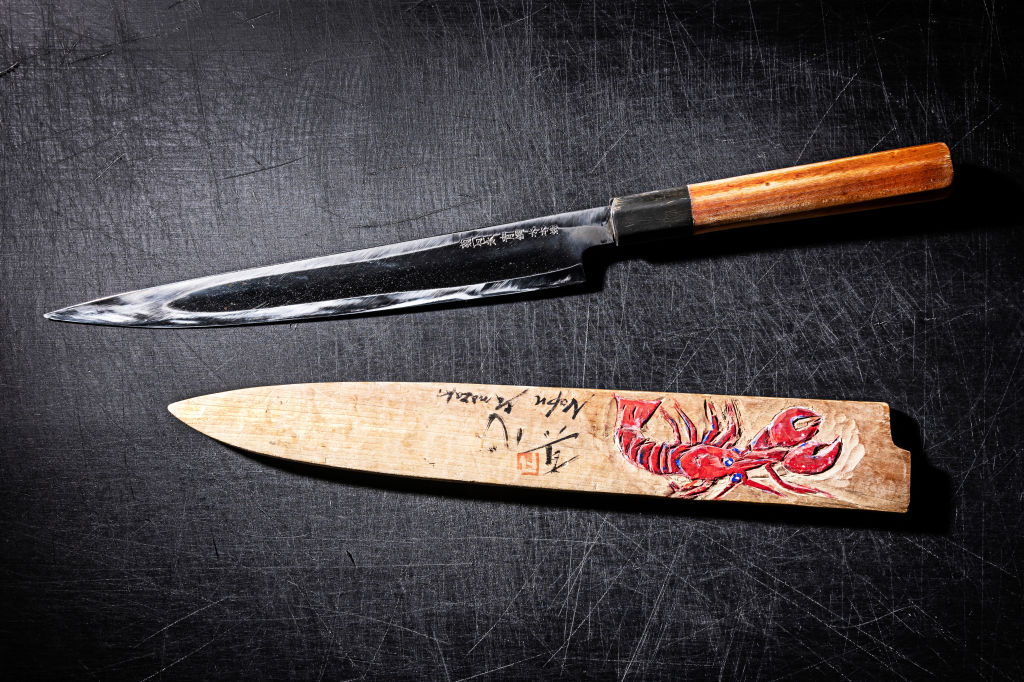Eat
 Chef Nobu Yamazaki's favorite knife. Photo by Scott Suchman.
Chef Nobu Yamazaki's favorite knife. Photo by Scott Suchman.
Clean Cut: A Conversation with Sushi Taro Chef Nobu Yamazaki
December 2, 2021 @ 12:00pm
In the hands of most cooks, a knife is simply a knife — an indispensable but ordinary kitchen tool meant to get the job done. But Nobu Yamazaki is no ordinary cook. To the chef and co-owner of Michelin-starred Sushi Taro in eastern Dupont, a knife is the most essential element of any Japanese restaurant.
“For French cooking, the sauce is essential,” he says. “For Chinese cooking, the fire. For the Japanese restaurant, the top chef’s job is cutting the fish; not cooking, seasoning or other things. Cutting is the most important element in Japanese cuisine.”
For that reason, choosing a knife is as personal as Harry Potter choosing a wand, especially when the knife is handmade and therefore one-of-a-kind.
“Even if their sizes are the same, each knife feels different,” he says. “It’s nice to be able to pick up and hold it in your hands — to feel that that’s the one.”
Behind The Photo
Yamazaki’s favorite knife is a carbon steel yanagi-style knife designed to cut fish for sushi and sashimi. He splurged on the pricey blade, which cost upward of $1,000, for his birthday about 15 years ago and says all other knives feel foreign to him now.
“Because each chef sharpens their own knife, each knife becomes part of you,” he says. “So even when I use my other chef’s knife — and his knife is as sharp as mine, or even sharper —the tiny bit difference of the angle created by years of daily sharpening is different. And our cutting is so precise. If I use somebody else’s knife, I can’t cut the way I want to.”
This particular knife, which Yamazaki bought from a traveling salesman that used to visit his restaurant every year or so, is stored in a wooden sheath adorned with a bright red lobster sporting blue highlights carved and painted by Yamazaki’s friend and mentor, sushi master Masayoshi Kazato. It’s inscribed with Yamazaki’s name and the Japanese characters for “magokoro,” which translates to something along the lines of “with all my heart.”
Yamazaki says he heard that Kazato would do these types of inscriptions when asked. Yamazaki took the opportunity to request one while helping Kazato with a lecture in Los Angeles — and says Kazato executed the charming embellishment overnight.
Adding a sentimental garnish to his workaday blade guard isn’t the only way Yamazaki shows his knife some love. His reliance on his trusty sidekick means he spends five minutes honing it at the end of each day, making sure it’s perfectly sharp, clean and ready for his next shift. And while perfection is always the ideal, he knows he’s only human.
“Each day, there’s always some cut that I feel like is the best cut of the day,” he says. “You try to make the best cut every day but it doesn’t always happen, of course. But when it does, you just feel it.”
The Meaning of Knife
There’s a sense that Yamazaki appreciates the paradox of knives: They are both routine and revered, menial and meaningful. They should be cared for, but perhaps not fetishized.
“It’s the same with Japanese ceramics,” he says. “Of course there’s some things you just put on display. But a nice bowl is meant to be used. You have a lot of feeling for it, but it’s still just a tool. I’m not a knife collector — I just have what I need. Some people have hundreds of knives. I have about 10.”
Used day in and day out, Yamazaki says a good quality carbon steel knife can last for decades. His still has a lot of life left in it, but he inherited a set of knives from a sushi chef who passed away and the well-worn blade that once looked like his has been honed down to a slender shaft — to the point it looks like an entirely different style of knife.
A knife might just be a tool, but the significance and eloquence embodied in this blade is not lost on Yamazaki.
“I don’t use it,” he says. “I just look at it. When I first saw it, I almost cried. It’s amazing. From time to time, I have to look at this knife to remind myself what it means to be a chef or what it means to hold a knife.”
Sushi Taro: 1530 17th St. NW, DC; 202-462-8999; sushitaro.com // @sushitarodc
A Cut Above
Yamazaki says one of the main mistakes non-chefs make with their blades is to assume knives stay sharp on their own without any work.
“Maintenance, taking care of the knife is the most important thing,” he says.
For those seeking to step up their at-home knife game, Masaya Kitayama — another chef at Sushi Taro — began a knife-sharpening service during the pandemic. Sushi Taro’s site features a link to Kitayama’s service, called TogiMax, and knives can be brought to either the restaurant or a Rockville location. Folks can also arrange for in-home pick-up and drop-off.
Kitayama also repairs knives and charges about $10 per knife per sharpening. Business picks up before the holidays, so book him early if you want your blades to be roast-carving ready.
Enjoy this piece? Consider becoming a member for access to our premium digital content. Support local journalism and start your membership today.







